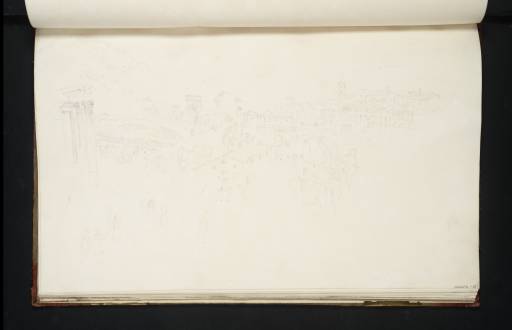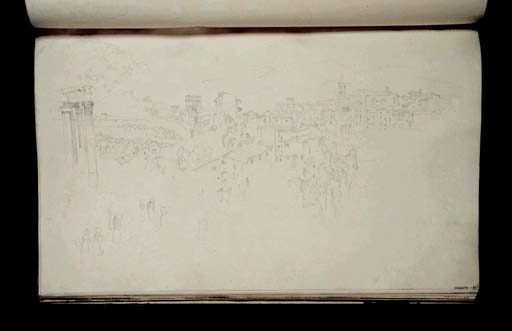Joseph Mallord William Turner View of Tivoli, with the So-Called Temple of Vesta 1819
Image 1 of 2
Joseph Mallord William Turner,
View of Tivoli, with the So-Called Temple of Vesta
1819
Joseph Mallord William Turner 1775–1851
Folio 27 Recto:
View of Tivoli, with the So-Called Temple of Vesta 1819
D16115
Turner Bequest CLXXXVII 27
Turner Bequest CLXXXVII 27
Pencil on white wove paper, 255 x 403 mm
Inscribed by John Ruskin in blue ink ‘27’ bottom right, descending right-hand edge
Stamped in black ‘CLXXXVII 27’ bottom right
Inscribed by John Ruskin in blue ink ‘27’ bottom right, descending right-hand edge
Stamped in black ‘CLXXXVII 27’ bottom right
Accepted by the nation as part of the Turner Bequest 1856
Exhibition history
1904
National Gallery, London, various dates to at least 1904 (252).
References
1904
E.T. Cook and Alexander Wedderburn (eds.), Library Edition: The Works of John Ruskin: Volume XIII: Turner: The Harbours of England; Catalogues and Notes, London 1904, no.252, pp.379, 622, as ‘Tivoli: The Temple of Vesta (near)’.
1909
A.J. Finberg, A Complete Inventory of the Drawings of the Turner Bequest, London 1909, vol.I, p.556, as ‘Tivoli, near the Temple of Vesta. Exhibited Drawings, No.252, N.G.’.
1920
D[ugald] S[utherland] MacColl, National Gallery, Millbank: Catalogue: Turner Collection, London 1920, p.86.
The subject of this sketch is a view of Tivoli from the so-called Temple of Vesta, a circular ruin dating from the first century BC, which stands on the edge of the gorge at the northern edge of the town. Part of the temple is visible on the far left-hand side of the composition, including two of the surviving Corinthian columns and the door of the inner cella. Turner’s high vantage point appears to be from the window of an inn known as ‘La Sibilla’, which stood immediately adjacent to the Temple.1 A similar view is the near-contemporaneous drawing by Turner’s collaborator, James Hakewill (1778–1843), Of the temple of the Sibyl etc. from the window of the ‘Locanda della Sibilla’ 1816 (British School at Rome Library).2 In his travel publication, A Classical Tour Through Italy, Revd John Chetwode Eustace recorded that the innkeeper of this establishment accepted an offer from Lord Bristol, Bishop of Derry (1730–1803), to purchase the temple and remove it to England, although the sale was ultimately prohibited by the government.3 Several figures, some in native costume, can be seen grouped around the base of the ruin and provide a sense of scale. For a detailed discussion of the Temple of Vesta and related studies see the Tivoli sketchbook (Tate D15513; Turner Bequest CLXXXIII 44a).
The prospect looks south-east across the gorge of the Valle d’Inferno (Valley of Hell) towards the heights of Monte Catillo on the left. Visible at the foot of the hill is the gate of Porta Cornuta with its medieval battlements (near present-day Piazzale Massimo). On the right-hand side of the view, the River Aniene curves its way through the town towards its former falling point, the ‘Grand Cascade’, caused by the dramatic descent of the waters into the valley. On the opposite side of the ravine is Santa Maria del Ponte, a church which stood at one end of the bridge overlooking the waterfall, the Ponte San Rocco. Both the church and the bridge were demolished during the works to divert the course of the river away from the residential district following a flood in 1826.
Unlike the watercolour or tonal studies on grey watercolour wash elsewhere in this sketchbook, Turner’s focus here is the accurate mapping of Tivoli’s topography with no indication of naturalistic or atmospheric effects. John Ruskin described the quality of the Tivoli sketches from nature as ‘unsurpassable’.4
Tony Cubberley and Luke Herrmann, Twilight of the Grand Tour: A Catalogue of the drawings by James Hakewill in the British School at Rome Library, Rome 1992, no.5.9, p.234, reproduced.
Verso:
Blank except for traces of watercolour; inscribed by an unknown hand in pencil ‘[?M]’ bottom right, ascending right-hand edge.
Nicola Moorby
February 2010
How to cite
Nicola Moorby, ‘View of Tivoli, with the So-Called Temple of Vesta 1819 by Joseph Mallord William Turner’, catalogue entry, February 2010, in David Blayney Brown (ed.), J.M.W. Turner: Sketchbooks, Drawings and Watercolours, Tate Research Publication, December 2012, https://www


